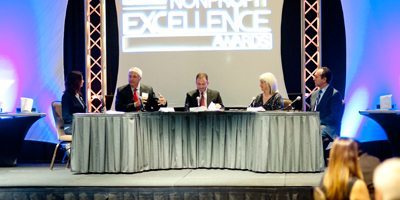When Dan Druml purchased Paul Davis Restoration & Remodeling in 2002, he took a risk.
“We had this great customer appreciation golf outing, but I thought we could do something more,” Druml said. “So I went back to the sales staff and said, ‘We’re going to make this a fee golf outing next year and charge everybody, and the money we make will all go to a charity.’”

Druml, president and chief executive officer of Paul Davis Restoration, told an audience of about 400 at the recent BizTimes Nonprofit Excellence Awards that he got some pushback at first, but the risk returned dividends he never expected.
“Everyone looks forward to this event every year,” he said. “Our customers are very engaged, our employees are very engaged and everyone gets really excited about the charity we support, a charity we get to give a lot of money to.”
Risk, innovation and collaboration are powerful themes that emerged during the Nonprofit Excellence Awards panel discussion featuring Druml; Paul Eberle, CEO of Whyte Hirschboeck Dudek SC; Tami Garrison, community affairs in Milwaukee for MillerCoors; and Neil Willenson, vice president of community relations for Kapco Metal Stamping. These business leaders described how corporate giving is part of their cultures.
“Our workforce at MillerCoors is interested in what we are doing in the community from a company perspective and they’re very interested in being involved,” Garrison said. “We take an integrated approach to philanthropy and look at how we activate our employees, engage our distributor and talk about it from a PR standpoint.”
When Eberle gave each employee at Whyte Hirschboeck Dudek $100 to just give away, he had no idea what he’d get.
“What jumped off the page after we did it the first year was the impact the individual stories had on our firm and, more importantly, the effect $100 has at a certain point in time in someone’s life,” he said.
Eberle recounted stories employees shared about how those dollars helped a waitress who was struggling, helped a neighbor who had lost his job buy groceries, and how employees pooled their dollars for higher impact.
Giving people the chance to innovate can inspire exciting ideas, Willenson said. A former nonprofit executive himself, Willenson encouraged nonprofit leaders in the room to approach business leaders with ideas.
“If a nonprofit approaches us with an endeavor, we love it,” he said. “Think about ways to partner with us – where employees can get involved; we can develop a campaign. Frankly, this is more sustainable.”
These strategies benefit the bottom lines of nonprofits and the brands of businesses, who, these leaders agreed, see strengthened recruitment and retention and stronger partnerships with customers, vendors and suppliers.
The real opportunity, Eberle pointed out, is for more Milwaukee area businesses to build philanthropy into their cultures.
“For our city to reach a better place, there is a lot of work that needs to be done,” he said. “Our nonprofits are incredibly important. We need to continue to push, to engage the employers of the region in creative problem solving. We need to continue to talk about the good work our nonprofits do and support them.”

